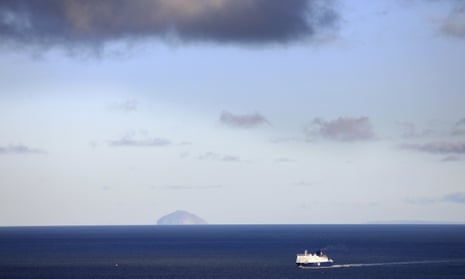Boris Johnson’s proposal for a bridge or tunnel linking Scotland to Northern Ireland has been rejected by a feasibility study as vastly expensive – £335bn for the bridge or £209bn for the tunnel – and fraught with potential difficulties.
Released alongside a wider so-called union connectivity review, which called for investment in road, rail and domestic aviation to better connect the four UK nations, the fixed link report found either a bridge or tunnel would be at the very edge of what could be achieved with current technology.
The tunnel would have to be so long and deep that it could only accommodate trains for safety reasons. It would take at least 30 years for either of the links to open.
A particular problem, which was raised by engineers when Johnson proposed the link in 2019, is Beaufort’s Dyke. The seabed trench is up to 300 metres deep and more than two miles wide at its broadest point, and is also filled with million tonnes of munitions dumped in the 1970s.
A tunnel would have to be constructed at depths of about 400 metres below water level, exerting significant pressures and requiring a 25-mile climb in either direction given a maximum rail gradient of one in 100.
By comparison the Channel tunnel is just over 23 miles long, with a maximum depth of 75 metres.
Beaufort’s Dyke would also prove “a challenge” for the bridge because the construction would have to pass over the trench, with a span of at least 2.5 miles and foundations set back from the edge, said the study, which was led by a small team of civil engineering experts.
No suspension bridge with a span that long has yet been built, the report said, although there have been some design concepts with similar lengths.
In an introduction to the feasibility report, Sir Peter Hendy, the chair of Network Rail, who led the connectivity review, said the study had concluded both projects were possible.
“A bridge crossing, however, would be the longest span bridge built to date,” he wrote. “A tunnel would be the longest undersea tunnel ever built given the limited gradients on which trains can operate, the route it would need to take and the depths it would need to reach.”
Building a rail link would also create “some complexity” because the track gauge in Northern Ireland is the same as in the Republic but different to that in the rest of the UK.
Hendy, who headed Transport for London when Johnson was mayor of the city, nonetheless said it had been “excellent question to ask”.
He wrote: “For many decades, politicians and engineers have debated this proposal, but have done so without the evidence to show whether it was possible and, if so, what it would take to do it. This is the first comprehensive, conclusive study on the subject since the idea was first mooted over 150 years ago.”
Johnson has a mixed record on proposals for ambitious bridges. As mayor of London he spent at least £37m of public money on a planned garden bridge over the Thames despite worries over funding, the project’s purpose and the lack of planning consents on one side of the river.
Among ideas in the wider connectivity review were investment in the west coast railway line north of Crewe to give better links to Scotland, something which goes beyond the £96bn rail plan announced last week, and an upgrade to the A75 road, which runs from the M6 near Gretna Green to the Scottish ferry port of Stranraer.







